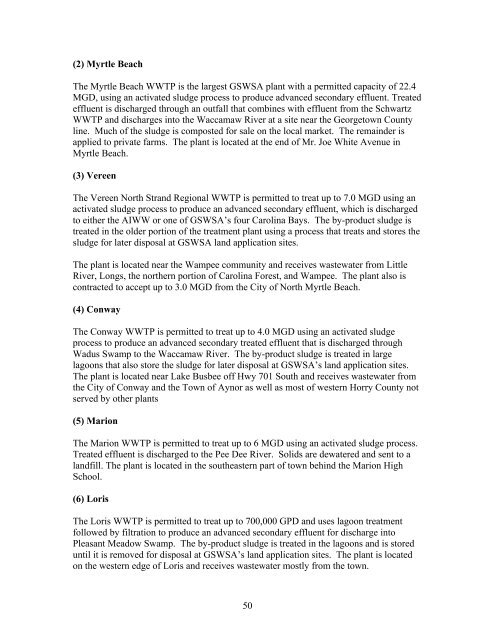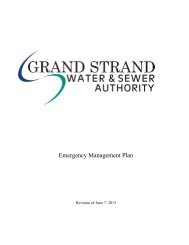2030 Plan - Grand Strand Water and Sewer Authority
2030 Plan - Grand Strand Water and Sewer Authority
2030 Plan - Grand Strand Water and Sewer Authority
Create successful ePaper yourself
Turn your PDF publications into a flip-book with our unique Google optimized e-Paper software.
(2) Myrtle Beach<br />
The Myrtle Beach WWTP is the largest GSWSA plant with a permitted capacity of 22.4<br />
MGD, using an activated sludge process to produce advanced secondary effluent. Treated<br />
effluent is discharged through an outfall that combines with effluent from the Schwartz<br />
WWTP <strong>and</strong> discharges into the Waccamaw River at a site near the Georgetown County<br />
line. Much of the sludge is composted for sale on the local market. The remainder is<br />
applied to private farms. The plant is located at the end of Mr. Joe White Avenue in<br />
Myrtle Beach.<br />
(3) Vereen<br />
The Vereen North <strong>Str<strong>and</strong></strong> Regional WWTP is permitted to treat up to 7.0 MGD using an<br />
activated sludge process to produce an advanced secondary effluent, which is discharged<br />
to either the AIWW or one of GSWSA’s four Carolina Bays. The by-product sludge is<br />
treated in the older portion of the treatment plant using a process that treats <strong>and</strong> stores the<br />
sludge for later disposal at GSWSA l<strong>and</strong> application sites.<br />
The plant is located near the Wampee community <strong>and</strong> receives wastewater from Little<br />
River, Longs, the northern portion of Carolina Forest, <strong>and</strong> Wampee. The plant also is<br />
contracted to accept up to 3.0 MGD from the City of North Myrtle Beach.<br />
(4) Conway<br />
The Conway WWTP is permitted to treat up to 4.0 MGD using an activated sludge<br />
process to produce an advanced secondary treated effluent that is discharged through<br />
Wadus Swamp to the Waccamaw River. The by-product sludge is treated in large<br />
lagoons that also store the sludge for later disposal at GSWSA’s l<strong>and</strong> application sites.<br />
The plant is located near Lake Busbee off Hwy 701 South <strong>and</strong> receives wastewater from<br />
the City of Conway <strong>and</strong> the Town of Aynor as well as most of western Horry County not<br />
served by other plants<br />
(5) Marion<br />
The Marion WWTP is permitted to treat up to 6 MGD using an activated sludge process.<br />
Treated effluent is discharged to the Pee Dee River. Solids are dewatered <strong>and</strong> sent to a<br />
l<strong>and</strong>fill. The plant is located in the southeastern part of town behind the Marion High<br />
School.<br />
(6) Loris<br />
The Loris WWTP is permitted to treat up to 700,000 GPD <strong>and</strong> uses lagoon treatment<br />
followed by filtration to produce an advanced secondary effluent for discharge into<br />
Pleasant Meadow Swamp. The by-product sludge is treated in the lagoons <strong>and</strong> is stored<br />
until it is removed for disposal at GSWSA’s l<strong>and</strong> application sites. The plant is located<br />
on the western edge of Loris <strong>and</strong> receives wastewater mostly from the town.<br />
50






